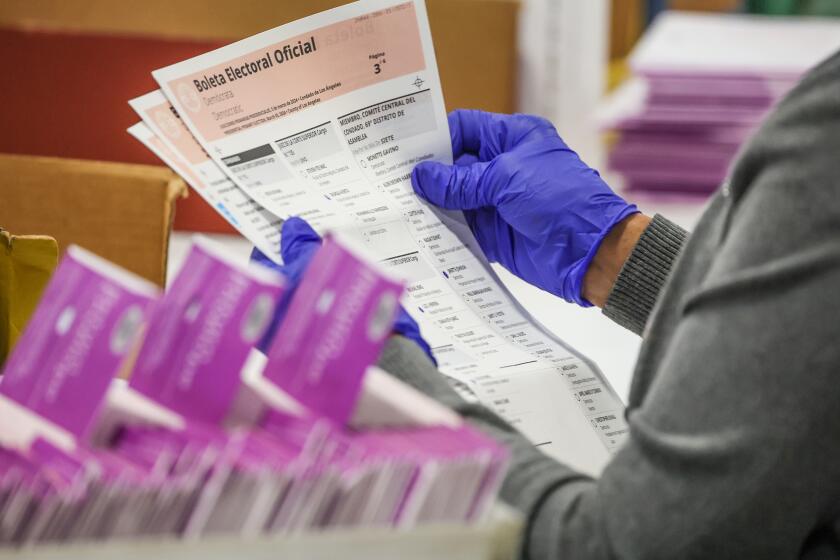U.S. to Challenge States on Medicaid Costs
- Share via
WASHINGTON — The Bush administration plans to confront state governments over Medicaid costs in an effort to slow the growth in federal spending on healthcare for the poor, disabled and elderly, Health and Human Services Secretary Michael Leavitt said Tuesday.
In a speech before a healthcare meeting here, Leavitt said Medicaid, the federal-state partnership to provide medical care for the needy, was “not financially sustainable.” He accused states of using accounting gimmicks to inflate their claims for reimbursement from Washington.
“We must have an uncomfortable but necessary conversation with our funding partners, the states,” he said.
Leavitt said his goal was to cut the growth in the cost of Medicaid from the current 10% a year to an annual rate of 7%.
Spurred by a weak economy that has increased the number of people eligible for Medicaid, spending on the program has risen in recent years to levels that present severe budget problems for most states. In some, the program has surpassed public education as the biggest budget item.
States have responded by seeking ways to shift more of the bill to the federal government. The cost of the program nationwide runs about $300 billion a year, with the federal government picking up more than 60%.
Now, with President Bush seeking to cut the federal deficit in half over the next five years, the fast-growing program has become the biggest target for healthcare cuts in the budget.
At the same time, the president has said he wants to expand coverage of uninsured children, many of whom are in low-income working families.
Medicaid covers about 50 million people, including children and nursing-home residents.
Leavitt said the federal government would begin to challenge Medicaid costs that states submitted for federal reimbursement, focusing on what he called “the seven harmful habits of highly desperate states.”
He declined to detail how the stratagems worked, but said the common denominator was that they artificially inflated a state’s costs.
Speaking less than a week before Bush is scheduled to unveil a detailed Medicaid plan in his new budget, Leavitt said the administration would not try to back out of responsibilities by converting the entire program into a block grant, as some Medicaid supporters had feared.
The former Utah governor said Medicaid represented “the spirit of American compassion in action,” and he pledged that services would be preserved for Medicaid’s core clients -- the poor, the disabled and the elderly in nursing homes.
But he left open the possibility of caps or limits for other services under the multifaceted program, which has grown to cover many low-income workers.
“There is a time in the life of every problem when it is big enough that you can see it but small enough that you can solve it,” Leavitt said. “With Medicaid, that window of opportunity is upon us.”
Sketching out some of the changes the administration will seek, Leavitt said he hoped to squeeze out as much as $40 billion over 10 years in projected federal savings by closing what he called loopholes that allowed states to inflate their costs.
He suggested an additional $15 billion could be saved over 10 years by revamping Medicaid’s drug coverage system. “We must stop overpaying for prescription drugs,” Leavitt said.
And he proposed an additional $4.5 billion in savings over 10 years by making it harder for elderly people to hide assets when they seek to qualify for Medicaid nursing-home coverage.
“Many older Americans take advantage of Medicaid loopholes to become eligible for Medicaid by giving away assets to their children,” he said. “There is a whole industry that actually helps people shift costs to the taxpayer. We must close these loopholes and focus Medicaid’s resources on helping those who really need it.”
Medicaid supporters are laying the political groundwork to try to stave off cuts in the upcoming budget.
They pointed to a study released last week by the Kaiser Family Foundation that found that surging Medicaid costs were mainly the result of covering more people in a weak economy. The study also found that Medicaid was more efficient at controlling administrative costs than was private insurance.
“If they push for $25 billion or $50 billion in cuts, you’re going to start kicking people off the rolls,” warned a state official who asked not to be identified. “That either means telling a bunch of grandmas they’re on the street or taking the number of uninsured to 50 million or 55 million. Neither of those options have good consequences.”
*
(BEGIN TEXT OF INFOBOX)
The recipients
About 50 million low-income Americans receive Medicaid. Children account for nearly half of the enrollees.
Data is for 2003.
Children: 48%
Adults: 27%
Disabled: 16%
Elderly: 9%
Source: Kaiser Commission on Medicaid and the Uninsured
More to Read
Sign up for Essential California
The most important California stories and recommendations in your inbox every morning.
You may occasionally receive promotional content from the Los Angeles Times.













